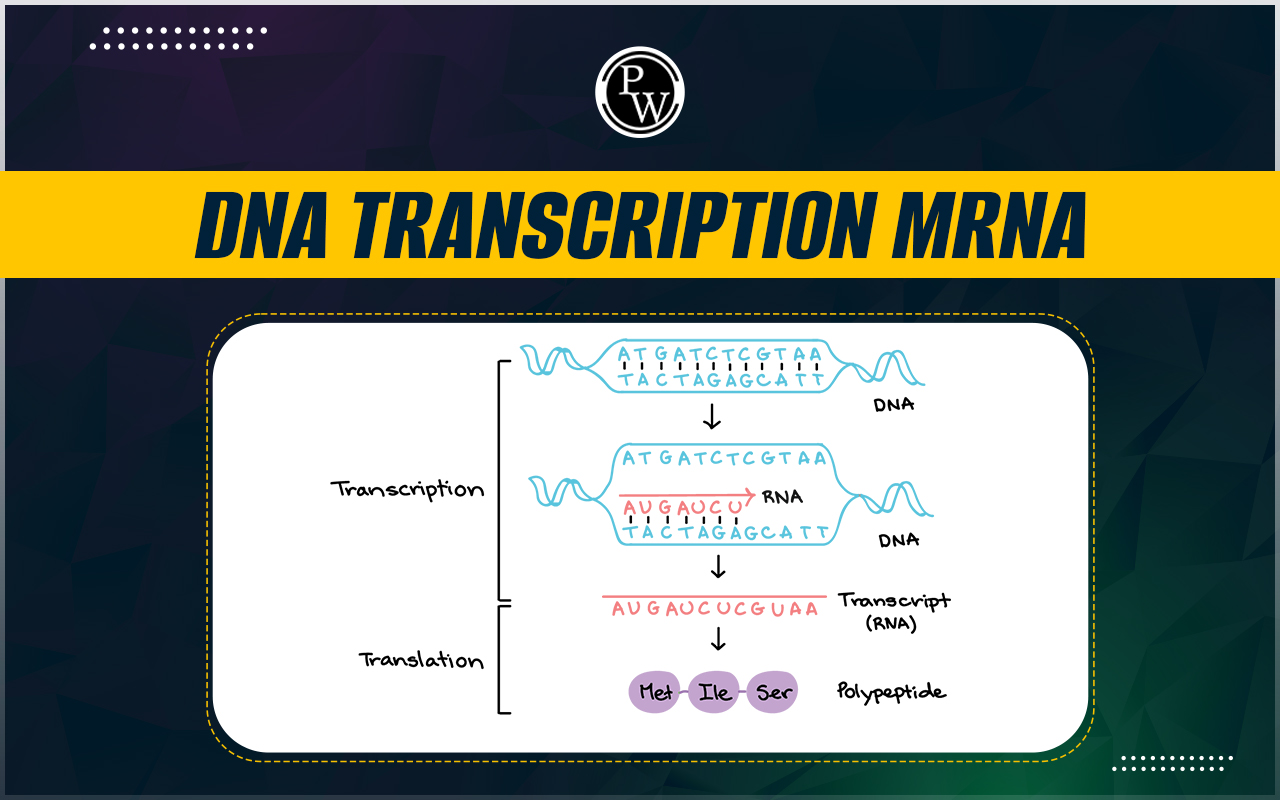

You have reached the proper destination if you were looking for information on the Stages, Processing, Applications of DNA Transcription mRNA .
This article provides a concise summary of mRNA transcription, including a description of the term and a rundown of the process's phases. This article aims to provide a synopsis of mRNA transcription and its importance in the field of medical research in as few words as possible. It is recommended that people who are pressed for time read at least the introductory paragraph and the important topics of the article.DNA Transcription
The copying of DNA into an RNA molecule is accomplished by a process known as DNA transcription. RNA polymerase is the enzyme responsible for carrying out this activity, which takes place in the nucleus of eukaryotic cells. During transcription, RNA polymerase reads the DNA sequence and then utilises it as a template to create a corresponding RNA molecule. This process is known as reverse transcription. The RNA molecule produced as a consequence is known as messenger RNA (mRNA), and its job is to transport genetic information from the DNA to the cytoplasm. The process of DNA transcription is complicated, consisting of various stages, such as the beginning, the middle, and the end of the process. Recognition of the promoter, unwinding of the DNA double helix, RNA synthesis, and RNA molecule release are the phases that make up DNA transcription. These phases are subject to stringent regulation and control by various transcriptional regulatory factors, which ensure that the proper genes are transcribed at the appropriate time and under the appropriate conditions.Messenger RNA (mRNA)
mRNA, shortened as messenger RNA, is a form of single-stranded RNA that plays a role in the production of proteins. During the transcription process, messenger RNA is generated from a template consisting of DNA. mRNA is responsible for transporting information about proteins from the DNA found in the nucleus of a cell to the cytoplasm of the cell. The machinery responsible for making proteins reads the mRNA sequence in the cytoplasm. It translates each three-base codon into the amino acid corresponding to it in a growing protein chain.mRNA Transcription Stages
The process that creates RNA from DNA is called transcription. In the 5' to 3' direction, RNA is synthesised by DNA-dependent RNA polymerase by utilising DNA as a template. The strand of DNA with polarity reading 3' to 5' ,,,,,,, is referred to as the template strand, whereas the strand with polarity reading 5' to, 3' is known as the coding strand. The coding strand and the transcribed RNA have the same order of nucleotides in their sequences. The three stages of transcription are:Initiation
Gene expression begins with the start stage of mRNA transcription. During this stage, the information contained in a particular gene is transcribed into RNA. This is the initial step in the process of gene expression. The following events occur during the process's first stages:- Recognition of the promoter : The promoter region of the DNA, which is responsible for signaling the location of the gene's start point, is recognised and bound to by RNA polymerase. RNA polymerase and other regulatory proteins detect certain sequences inside the promoter. These sequences determine whether or not transcription is allowed to begin.
- Unwinding of the DNA Double Helix : To access the template strand, RNA polymerase must first unwind the DNA double helix located at the gene's start site.
- Assembly of the Pre-Initiation Complex : The association of RNA polymerase with many other transcription factors and co-factors results in the formation of a complex called the pre-initiation complex. This complex is necessary for RNA polymerase to be positioned correctly at the start site of the gene and for transcription to begin.
- RNA Synthesis : RNA polymerase initiates the production of RNA by adding ribonucleotides that are complementary to the strand of DNA that serves as the template. The direction in which the RNA molecule is generated, known as the 5' to 3' direction, is called the main transcript.
Disorders of the Circulatory System
Elongation
The synthesis of an RNA molecule using a DNA template is what happens during the elongation step of the messenger RNA transcription process. The processes described below occur during elongation:- Movement of RNA Polymerase : Synthesis of the RNA molecule occurs as RNA polymerase travels along the DNA template it is attached to. The RNA molecule is constructed in the 5' to 3' orientation, with ribonucleotides complementary to the template strand of DNA being added by RNA polymerase.
- Interaction with Transcriptional Regulatory Factors : RNA polymerase interacts with transcriptional regulatory factors, each of which has the potential to affect the pace of transcription and the precise position at which it is terminated. Depending on the signals they get from the surrounding environment of the cell, these factors can either stimulate or inhibit the transcription process.
- Processive Synthesis : RNA polymerase can engage in processive synthesis, which indicates that it can sustain RNA synthesis for lengthy periods of time without being detached from the DNA template. Because of this, the synthesis of RNA from lengthy genes may be carried out in an effective and uninterrupted manner.
Diphtheria: Types, Symptoms, Causes, Treatment
Termination
The production of an RNA molecule from a DNA template is completed with a step called the termination phase of messenger RNA transcription. This step is the last in the process. The following processes are carried out during conclusion:- Reach of the Termination Site : When RNA polymerase gets to the very end of the gene, it runs across a termination signal, which tells it that the transcription process is now complete. This signal may be a particular DNA sequence or interaction with transcriptional regulatory components.
- Release of the RNA Molecule : RNA polymerase releases the freshly manufactured RNA molecule once it reaches the termination signal. After this step, the RNA molecule can undergo further processing and modification. At this point, it is prepared to be transferred to the cytoplasm to undergo translation.
- Dissociation of RNA Polymerase and Transcriptional Factors : After dissociating from the DNA template, RNA polymerase and other transcriptional components are free to start transcription at another gene.
mRNA Processing
The unprocessed mRNA molecules in the nucleus are called pre-mRNA. This group of molecules is called the hnRNA (Heterogeneous nuclear RNA). It is mostly made up of pre-mRNA molecules, which cannot develop into mRNA molecules unless they undergo significant processing. To develop into mature mRNA, hnRNA must first be processed. More processing steps are required to create mature RNA from it:- Splicing: mRNA splicing is a process that involves removing introns from the mRNA molecule that do not code for a protein and joining together exons that do code for a protein. This enables the messenger RNA (mRNA) to transport just the information necessary for the production of a protein, which produces numerous distinct proteins from a single gene. The spliceosome is a complex made up of proteins and RNA that is responsible for carrying out the process of splicing. This complex identifies and removes introns from the mRNA.
Related Links -
- Capping : In capping mRNA, a modified guanine nucleotide known as the 7- methylguanosine cap is attached to the 5' end of the mRNA molecule. This process is known as "capping." This serves to preserve the mRNA from degradation, which improves its stability as well as the effectiveness of its translation and allows it to attach to the ribosome so that it can be translated.
- Tailing : Tailing refers to adding additional adenosine residues (A's) to the 3' end of the molecule. This takes place after the mRNA molecule has been transcribed and spliced, and it can potentially influence both the mRNA's stability and its translation. A specific form of RNA polymerase, poly (A) polymerase, is responsible for tailing. This process involves the addition of additional adenosine residues to the 3' end of the mRNA. The length of the poly(A) tail can be regulated, and the stability of the mRNA as well as the translation of it, can be affected differently depending on the length of the poly(A) tail.
Applications of mRNA Transcription
There are many essential uses for mRNA transcription in a variety of sectors, including biotechnology, medicine, and research, to name a few. The following are some of the most important applications:- Gene expression analysis : The study of gene expression patterns and levels in various tissues or circumstances may be accomplished through mRNA transcription, which can provide insights into the cellular processes and disease mechanisms involved.
- RNA interference (RNAi) : Small RNA molecules, as part of the process known as RNA interference (RNAi), seek for and destroy particular mRNA molecules, thereby inhibiting the production of particular genes. This technique may be used in the research and development of new drugs and in the diagnosis and treatment of genetic illnesses.
- Vaccine development : It is possible to employ mRNA transcription to create mRNA that encodes a viral protein, which may subsequently be utilised in manufacturing vaccines. Vaccines against COVID-19 that are based on mRNA have been developed with the help of this.
- Gene therapy : mRNA has the potential to be utilised in the delivery of therapeutic genes to cells, enabling the repair of genetic mutations that are the root cause of illness.
- Discovery of drugs : The production of proteins for drug screening may be accomplished through mRNA transcription, which paves the way for the discovery of novel medications to cure ailments.
Related Links -
DNA Transcription mRNA <span style=
How is the information contained in DNA converted into a functional protein?
Following a sequence of stages known as transcription, translation, and protein folding, the information contained in DNA is converted into a protein that can perform its intended function. The information contained in DNA is copied into mRNA during the transcription process. When building a protein, the ribosome refers to the instructions in the messenger RNA for guidance. At long last, the protein assumes the structure necessary to function.
How is mRNA transcription regulated?
mRNA transcription may be regulated at several levels, such as the activity of gene promoters, the structure of chromatin, and the modifications that occur after transcription.
Within the context of the cell, what function does mRNA serve?
The genetic information is carried from the DNA in the nucleus to the ribosomes in the cytoplasm, where it is translated into a protein. mRNA is located in both the nucleus and the cytoplasm.
How does mRNA transcription impact gene expression?
Changes in the amounts of mRNA transcription can affect the quantity of mRNA that can be translated into protein. Because of this, mRNA transcription is an essential stage in regulating gene expression.
Can mRNA transcription be used for therapeutic purposes?
Yes, mRNA transcription does indeed have a lot of therapeutic uses. Some of these applications include RNA interference, gene therapy, and the production of vaccines.
After transcription, what changes take place in the mRNA?
Following the transcription process, mRNA is moved from the nucleus into the cytoplasm, which serves as a blueprint for the subsequent synthesis of proteins.
🔥 Trending Blogs
Talk to a counsellorHave doubts? Our support team will be happy to assist you!

Check out these Related Articles
Free Learning Resources
PW Books
Notes (Class 10-12)
PW Study Materials
Notes (Class 6-9)
Ncert Solutions
Govt Exams
Class 6th to 12th Online Courses
Govt Job Exams Courses
UPSC Coaching
Defence Exam Coaching
Gate Exam Coaching
Other Exams
Know about Physics Wallah
Physics Wallah is an Indian edtech platform that provides accessible & comprehensive learning experiences to students from Class 6th to postgraduate level. We also provide extensive NCERT solutions, sample paper, NEET, JEE Mains, BITSAT previous year papers & more such resources to students. Physics Wallah also caters to over 3.5 million registered students and over 78 lakh+ Youtube subscribers with 4.8 rating on its app.
We Stand Out because
We provide students with intensive courses with India’s qualified & experienced faculties & mentors. PW strives to make the learning experience comprehensive and accessible for students of all sections of society. We believe in empowering every single student who couldn't dream of a good career in engineering and medical field earlier.
Our Key Focus Areas
Physics Wallah's main focus is to make the learning experience as economical as possible for all students. With our affordable courses like Lakshya, Udaan and Arjuna and many others, we have been able to provide a platform for lakhs of aspirants. From providing Chemistry, Maths, Physics formula to giving e-books of eminent authors like RD Sharma, RS Aggarwal and Lakhmir Singh, PW focuses on every single student's need for preparation.
What Makes Us Different
Physics Wallah strives to develop a comprehensive pedagogical structure for students, where they get a state-of-the-art learning experience with study material and resources. Apart from catering students preparing for JEE Mains and NEET, PW also provides study material for each state board like Uttar Pradesh, Bihar, and others
Copyright © 2025 Physicswallah Limited All rights reserved.
Get App











